The Pacific Long-tailed Cuckoo (Eudynamys taitensis), a captivating avian species, commands attention with its distinctive features and intriguing behavior.
Native to the Pacific Islands, this medium-sized cuckoo stands out for its striking long tail, a defining characteristic that sets it apart from its avian counterparts.
With a sleek plumage characterized by a contrasting palette of dark and light hues, the Pacific Long-tailed Cuckoo is a visually captivating species.
Known for its enigmatic migratory patterns and unique reproductive strategy involving parasitism, this bird has earned a reputation as a fascinating subject for ornithologists and bird enthusiasts alike.
As a significant component of the diverse avian tapestry in the Pacific region, the Pacific Long-tailed Cuckoo plays a vital role in the ecosystems it inhabits, contributing to the ecological balance.
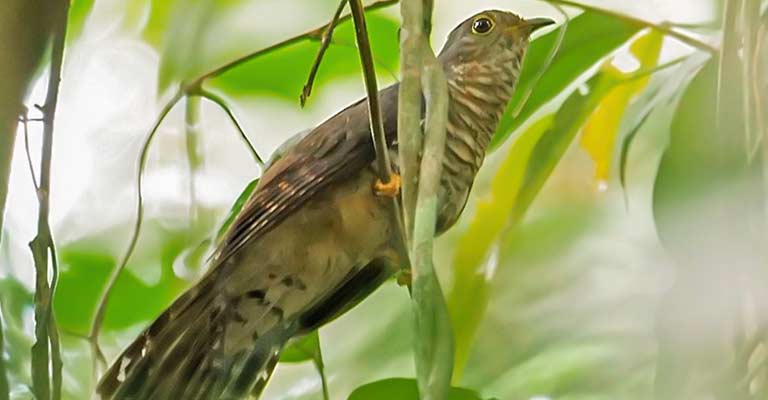
Individualizing Criteria of Pacific Long-tailed Cuckoo
Identifying the Pacific Long-tailed Cuckoo (Eudynamys taitensis) involves a keen observation of distinctive features, behaviors, and habitat preferences. Here are eight key criteria for recognizing this unique avian species:
Distinctive Long Tail
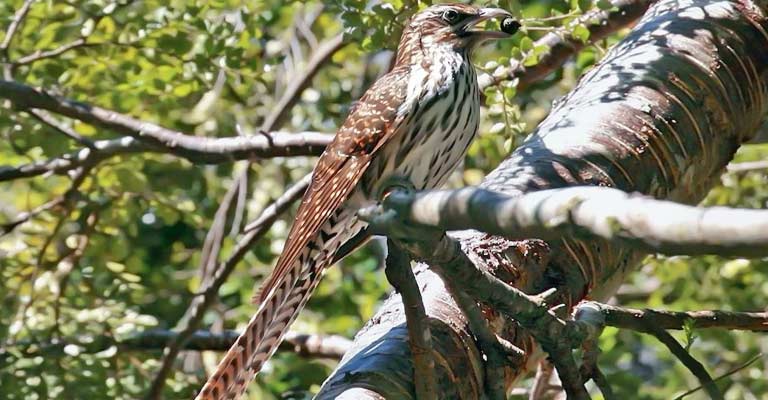
The most prominent feature of the Pacific Long-tailed Cuckoo is its exceptionally long tail, extending well beyond its body. The tail feathers are sleek and pointed, creating a striking visual impression.
This characteristic sets it apart from other cuckoos and birds in the region, making it a crucial identification factor.
Plumage Coloration
The bird exhibits a combination of dark and light plumage, creating a visually captivating contrast.
The upperparts are generally dark brown or black, while the underparts are adorned with lighter shades, often featuring a subtle blend of gray, white, and buff.
The distinct color pattern aids in distinguishing it from other avian species within its habitat.
Size and Shape
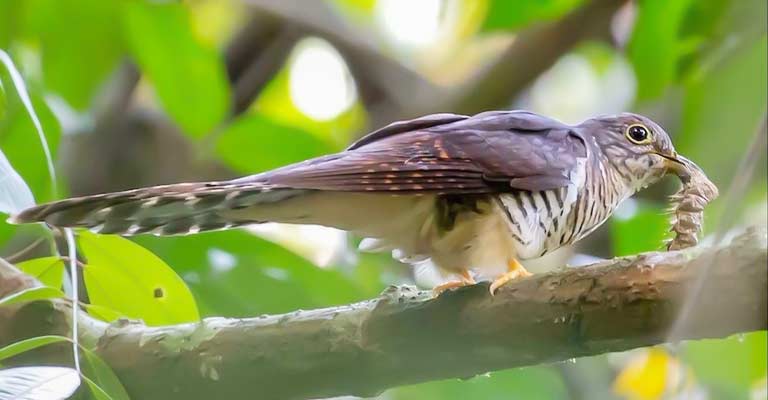
The Pacific Long-tailed Cuckoo is of medium size, measuring approximately 35 to 40 centimeters in length. Its slender and elongated body, coupled with the aforementioned long tail, contributes to a distinctive silhouette.
Paying attention to the overall size and shape helps in quickly differentiating it from similar-looking birds in the area.
Facial Markings
The bird features distinct facial markings that aid in identification. A striking black stripe extends across its eye, contrasting with the surrounding plumage.
This eye-catching facial pattern, along with a distinctive bill shape, assists birdwatchers and researchers in accurately recognizing the Pacific Long-tailed Cuckoo.
Vocalizations
The bird’s unique vocalizations provide an audible clue to its presence. Its calls are a mix of melodious notes and distinctive calls that echo through the tropical landscape.
Learning to recognize these vocalizations is essential for identifying the Pacific Long-tailed Cuckoo, especially in dense vegetation where visual confirmation may be challenging.
Migratory Patterns
Recognizing the Pacific Long-tailed Cuckoo may also involve understanding its migratory patterns.
This species is known for its seasonal movements, and being aware of when and where these migrations occur can aid in accurate identification during specific times of the year.
Behavioral Traits
The bird’s behavior offers additional identification cues. The Pacific Long-tailed Cuckoo is often observed perched high in the canopy, utilizing its long tail for balance.
Additionally, its foraging behavior, characterized by swift flights to catch insects in mid-air, contributes to its distinctiveness.
A holistic approach combining visual and auditory cues, knowledge of habitat preferences, and an awareness of behavioral traits is essential for confidently identifying the Pacific Long-tailed Cuckoo in its natural environment.
As with many bird species, a patient and attentive observer stands a greater chance of successfully recognizing this captivating avian resident of the Pacific region.
Taxonomy of Pacific Long-tailed Cuckoo
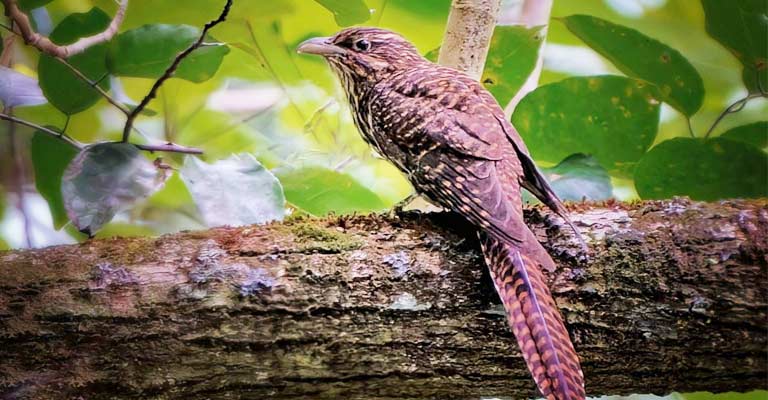
Here is a table containing all the necessary info about the taxonomy details of the Pacific Long-tailed Cuckoo:
| Taxonomic Rank | Classification |
| Domain | Eukaryota |
| Kingdom | Animalia |
| Phylum | Chordata |
| Class | Aves |
| Order | Cuculiformes |
| Family | Cuculidae |
| Genus | Urodynamis |
| Species | U. taitensis |
The Pacific Long-tailed Cuckoo (Eudynamys taitensis) belongs to the avian family Cuculidae, commonly known as cuckoos.
This species is classified under the genus Eudynamys. Within the order of Cuculiformes, Pacific Long-tailed Cuckoos are characterized by their distinctive long tails, medium-sized bodies, and unique plumage coloration.
As a migratory bird native to the Pacific Islands, their taxonomic placement highlights their evolutionary relationships with other members of the cuckoo family, emphasizing their role in the avian biodiversity of the region and the broader context of global bird taxonomy.
Common Food of Pacific Long-tailed Cuckoo
The Pacific Long-tailed Cuckoo (Eudynamys taitensis) exhibits a diverse diet consisting mainly of insects and other invertebrates.
Its foraging habits are primarily focused on locating prey in the dense vegetation of forests, both primary and secondary.
The bird employs its agile flight and long tail for swift movements, capturing prey in mid-air or from perches within the canopy. Common foods in the Pacific Long-tailed Cuckoo’s diet include:
- Insects: A wide variety of insects, such as beetles, caterpillars, and grasshoppers, form a significant part of their diet.
- Arachnids: Spiders and other arachnids contribute to the bird’s protein intake.
- Small Reptiles: Occasional consumption of small reptiles, like lizards, supplements their diet.
- Fruits: While not a primary food source, Pacific Long-tailed Cuckoos may consume fruits, providing essential nutrients and variety to their diet.
This adaptability in diet showcases the bird’s ecological flexibility and its ability to thrive in diverse habitats within the Pacific Islands.
Reproduction of Pacific Long-tailed Cuckoo
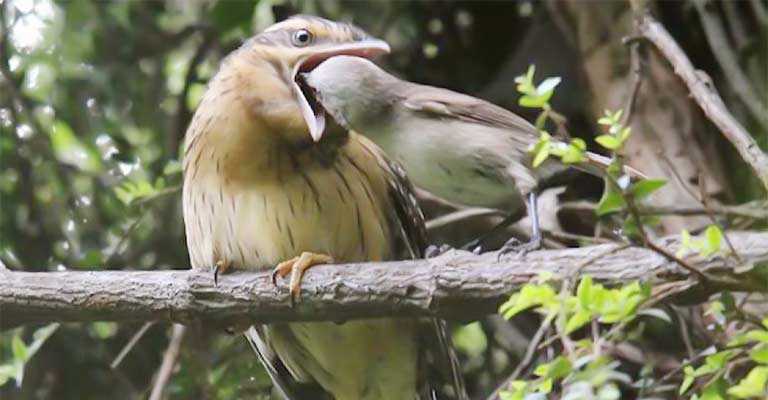
The reproduction process of the Pacific Long-tailed Cuckoo (Eudynamys taitensis) involves unique and intriguing habits.
Known for practicing brood parasitism, the female Pacific Long-tailed Cuckoo lays its eggs in the nests of other bird species. The unsuspecting host birds then incubate and raise the cuckoo’s eggs alongside their own, often at the expense of their natural offspring.
This reproductive strategy allows the Pacific Long-tailed Cuckoo to minimize the energy investment required for raising its young. Once hatched, the cuckoo chicks often outcompete or eliminate the host chicks, ensuring the survival of their kind.
This evolutionary adaptation showcases the remarkable reproductive tactics employed by the Pacific Long-tailed Cuckoo, contributing to its survival in the complex ecosystems of the Pacific Islands.
Pacific Long-tailed Cuckoo Life History
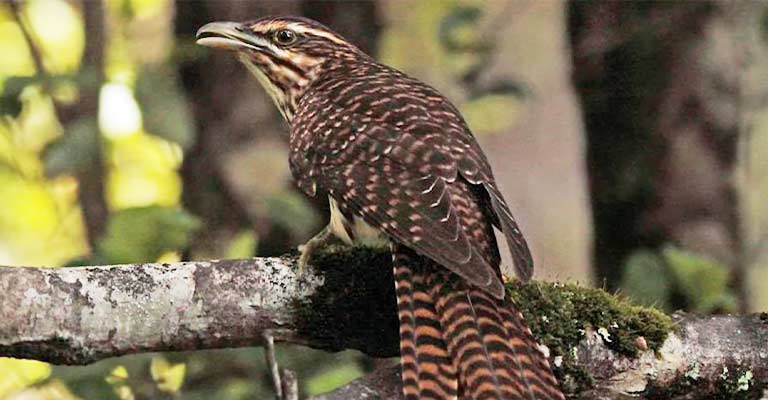
The Pacific Long-tailed Cuckoo (Eudynamys taitensis) boasts a captivating life history, marked by distinctive behaviors and adaptations.
From its habitat preferences to reproductive strategies, foraging habits, and conservation status, each aspect contributes to the avian tapestry of the Pacific Islands.
Habitat
The Pacific Long-tailed Cuckoo thrives in the lush vegetation of the Pacific Islands, occupying a range of habitats from primary and secondary forests to wooded areas.
It exhibits a preference for environments that provide suitable perches for hunting insects and other prey.
Range Map
The species’ range extends across various Pacific Islands, showcasing its adaptability to diverse ecosystems. A detailed range map illustrates its distribution, emphasizing its presence in specific regions and migration patterns.
Nesting
The reproductive strategy of the Pacific Long-tailed Cuckoo involves brood parasitism. Females lay their eggs in the nests of other bird species, relying on unsuspecting hosts to incubate and raise their chicks.
This unique approach minimizes the energy investment required for parental care.nCertainly! Here’s a table summarizing the nesting details of the Pacific Long-tailed Cuckoo (Eudynamys taitensis):
| Nesting Details | Pacific Long-tailed Cuckoo |
| Clutch Size | Typically 1-2 eggs |
| Number of Broods | Usually a single brood per year |
| Egg Length | Approximately 3.5 to 4.5 cm |
| Egg Width | Approximately 2.5 to 3 cm |
| Incubation Period | Around 13-15 days |
| Nestling Period | About 14-18 days |
| Egg Description | Oval-shaped, varying colors, often with subtle markings |
| Nest Type | Parasitic nesting, placing eggs in host bird nests |
| Nest Location | Often laid in the nests of other bird species |
| Parental Involvement | Minimal, as the host birds primarily care for the eggs and chicks |
Hunting
Equipped with a long tail and agile flight, the Pacific Long-tailed Cuckoo is an adept hunter. Its diet primarily consists of insects, arachnids, and occasionally small reptiles.
Swift movements and keen foraging skills contribute to its success in capturing prey.
Diseases
Like many avian species, the Pacific Long-tailed Cuckoo may face health challenges. Common avian diseases, such as respiratory infections or parasitic infestations, can impact individual birds and populations.
Treatment
Efforts to mitigate the impact of diseases on Pacific Long-tailed Cuckoo populations involve veterinary interventions and habitat management.
Monitoring health indicators and implementing conservation measures play a crucial role in supporting the well-being of these birds.
Conservation
While not currently classified as globally threatened, the conservation status of the Pacific Long-tailed Cuckoo relies on preserving its habitat, understanding migration patterns, and addressing potential threats.
Conservation initiatives aim to maintain the delicate balance of ecosystems, ensuring the long-term survival of this unique avian species.
In essence, the life history of the Pacific Long-tailed Cuckoo intertwines with the ecological intricacies of the Pacific Islands, showcasing the bird’s adaptability and the ongoing efforts required for its conservation and sustainable coexistence within its diverse habitats.
10 Surprising Facts About Pacific Long-tailed Cuckoo
The Pacific Long-tailed Cuckoo (Eudynamys taitensis) stands as a captivating and enigmatic avian species native to the Pacific Islands.
Beyond its distinctive appearance and unique reproductive strategy, several surprising facts contribute to the allure of this bird.
- Migratory Marvel: Contrary to the sedentary lifestyle of many cuckoo species, the Pacific Long-tailed Cuckoo is a remarkable migratory bird. It undertakes seasonal journeys across the Pacific Islands, showcasing its adaptability and navigation skills.
- Long-Tailed Elegance: The bird’s most striking feature is its long tail, which exceeds its body length. This elegant appendage aids in balance during flight and serves as a visual spectacle, distinguishing it from other avian counterparts.
- Parasitic Parenting: The Pacific Long-tailed Cuckoo employs brood parasitism as a reproductive strategy. Instead of constructing its nest, it lays eggs in the nests of other bird species, relying on unwitting hosts to incubate and rear its chicks.
- Vocal Symphony: Its melodic and varied calls create a symphony in the tropical forests it inhabits. The bird’s vocalizations, ranging from melodious notes to distinctive calls, contribute to the auditory richness of its ecosystem.
- Cryptic Coloration: The plumage of the Pacific Long-tailed Cuckoo is characterized by a cryptic blend of dark and light hues, providing effective camouflage within the dense vegetation it frequents.
- Egg Imitation Game: The eggs laid by the Pacific Long-tailed Cuckoo often mimic those of its host species. This deceptive adaptation increases the likelihood of successful incubation by host birds, further illustrating the bird’s evolutionary cunning.
- Elusive Foraging Techniques: When hunting for insects, the Pacific Long-tailed Cuckoo displays agile and elusive flight patterns. Its swift movements in mid-air contribute to its success as an insectivore in the dense canopy.
- Nomadic Nester: With a preference for a variety of forested habitats, this cuckoo species is known for its nomadic nesting habits. It adapts to different environments, showcasing its ecological flexibility.
- Island Endemism: The Pacific Long-tailed Cuckoo is an island endemic species, emphasizing its unique evolution within specific island ecosystems and its role in maintaining ecological balance.
- Conservation Concerns: Despite not being classified as globally threatened, ongoing conservation efforts are crucial to preserving the Pacific Long-tailed Cuckoo’s habitat and addressing potential threats, ensuring the sustainability of this fascinating bird.
Intriguing and adaptable, the Pacific Long-tailed Cuckoo continues to unveil surprises, making it a subject of fascination for ornithologists and nature enthusiasts exploring the avian wonders of the Pacific Islands.
Wrapping Up
The Pacific Long-tailed Cuckoo emerges as a captivating avian species, weaving a tapestry of unique characteristics and behaviors that enrich the biodiversity of the Pacific Islands.
Its long tail, migratory marvels, and brood parasitism stand out as distinctive features, captivating the imagination of bird enthusiasts and researchers alike.
From the melodic symphony echoing through the tropical forests to its cryptic plumage and deceptive nesting strategies, each facet of this bird’s life history reveals the intricate dance of adaptation and survival in island ecosystems.
As we delve into the surprising facts and ecological nuances surrounding the Pacific Long-tailed Cuckoo, it becomes apparent that the conservation of this species is paramount.
Its nomadic nesting habits, coupled with potential threats to its habitat, emphasize the delicate balance required for its continued existence.